Category: Communication Tips

Stop Rumors Before They Ruin Your Brand
Seriously–how does this stuff get started?
Like many of you, one of my goals for 2019 has been to focus on wellness, and that includes more exercise. Since options are limited here in snowy, cold Iowa in the winter, I’m glad there’s an indoor swimming pool nearby that’s open to the public a few hours a day.
I was swimming with some of my friends this morning, and one of them asked, “Have you sent that email yet?” I didn’t know what she was talking about, and she said she’s trying to encourage people who use the pool to let the facility’s administrator let know how much the community values the pool and how we don’t want it to close.
Turns out there’s a rumor swirling around that the cost of maintaining the pool might be prompting people in charge of the facility to close the pool. Distressing information, indeed.
I was glad when another one of my friends (one who works at the facility) stopped by to said hi while I was in the water. I asked if the talk about closing the pool was true.
“Where did you hear that?”
We told her the rumor was going around town. “No, this pool is important,” she said. “We have no plans to close it down.”
Not only was I relieved, but I started thinking about another conversation I had at the pool this morning. One of my friends brought up the name of the administrator of a large organization in town–but she admitted she wasn’t sure what the lady’s name was. Smith? Jones? Not sure.
All of us in the pool agreed that we knew little about this person. We also agreed how important it is for an organization (and those who lead it) to remain visible and keep the lines of communication open.
I wonder how many rumors, snippets of misinformation and flat-out lies could be countered effectively if people–especially business leaders–would stay in touch regularly with employees, customers, prospects, donors, the media and other key audiences. I’m not talking about a once-and-done approach, either.
In my experience, the best approach involves an ongoing commitment to sharing true stories well told through blog posts, e-newsletters, magazine articles, social media posts, videos and more) to add value for your audience. Along the way, you establish yourself as a trusted leader.
It’s an approach worth considering, especially in a world where a lie told often enough tends to become the truth.
Want more?
Thanks for stopping by. I invite you to read more of my blog posts if you value intriguing Iowa stories and history, along with Iowa food, agriculture updates, recipes and tips to make you a better communicator.
If you like what you see and want to be notified when I post new stories, be sure to click on the “subscribe to blog updates/newsletter” button at the top of this page, or click here. Feel free to share this with friends and colleagues who might be interested, too.
Also, if you or someone you know could use my writing services (I’m not only Iowa’s storyteller, but a professionally-trained journalist with 20 years of experience), let’s talk. I work with businesses and organizations within Iowa and across the country to unleash the power of great storytelling to define their brand and connect with their audience through clear, compelling blog posts, articles, news releases, feature stories, newsletter articles, social media, video scripts, and photography. Learn more at www.darcymaulsby.com, or e-mail me at yettergirl@yahoo.com.
If you’re hungry for more stories of Iowa history, check out my top-selling “Culinary History of Iowa: Sweet Corn, Pork Tenderloins, Maid-Rites and More” book from The History Press. Also take a look at my latest book, “Dallas County,” and my Calhoun County” book from Arcadia Publishing. Both are filled with vintage photos and compelling stories that showcase he history of small-town and rural Iowa. Order your signed copies today! Iowa postcards are available in my online store, too.
Let’s stay in touch. I’m at darcy@darcymaulsby.com, and yettergirl@yahoo.com.
Talk to you soon!
Darcy
@Copyright 2019 Darcy Maulsby & Co. Blog posts may only be reprinted with permission from Darcy Maulsby.
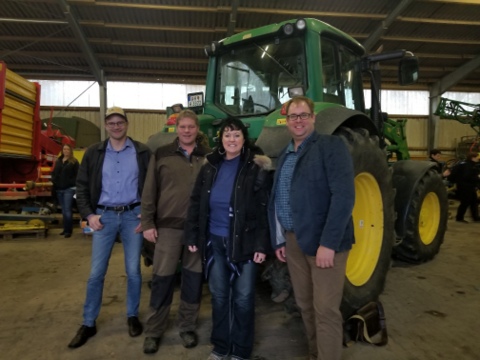
Ag-Vocating Worldwide: Top 10 Tips for Sharing Ag’s Story with Consumers
Any of these sound familiar? Many consumers today don’t understand modern agriculture. Activists are spreading misinformation about farming. Myths about farming seem to carry more weight than facts. I couldn’t believe what I was hearing. While these things are top of mind for me here in Iowa, they’re hot topics in Germany and across Europe, too.
So what do you do about it? We shared best practices when I joined five other ag leaders from Iowa in northern Germany to meet with European farmers, veterinarians and other ag professionals during the Transatlantic Agricultural Dialogue on Consumer Engagement from November 11-16, 2018.
“This experience highlighted why we must make time to share the what and why of how we do things on the farm,” said my friend Chad Ingels, a farmer from Randalia, Iowa, who participated in the Germany study trip, which was supported by the German-American Chamber of Commerce. “Consumers around the world really have no idea what happens in the day-to-day activities on the farm. We need to share our story and keep it simple, without using ‘farmer jargon.’”
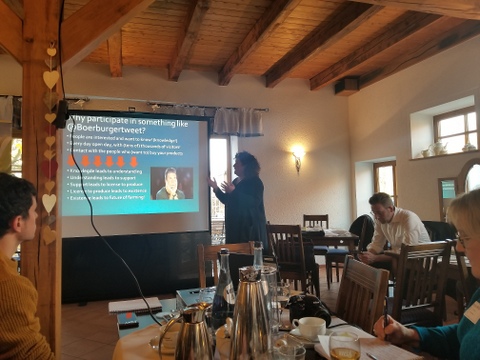
Learning practical tips in Germany for telling ag’s story effectively
Ingels, who raises corn, soybeans and hogs and is active on social media, appreciated the opportunity to exchange practical ideas to address the public’s questions about food production. During these discussions, ag leaders from both sides of the Atlantic shared their 10 top tips for engaging with consumers, including:
1. Be willing to engage. Who is telling agriculture’s story, and what are they saying? Don’t leave it to chance, said Caroline van der Plas from the Netherlands, who encourages farmers to build relationships and share their story with consumers, the media and lawmakers. “If you don’t share your story, others like People for the Ethical Treatment of Animals (PETA) will tell it for you,” said van der Plas, who coordinates the Dutch social media project @boerburgertweet, which allows farmers to share their story with consumers on Twitter.
The ripple effect from one story can be powerful, noted Janice Person, online engagement director for Bayer CropScience. She credits one interview more than 20 years ago with Louisiana farmer Ray Young for motivating her to pursue an agricultural communications career. “I was a city girl from Memphis who was interested in ecology,” said Person, keynote speaker at the Transatlantic Agricultural Dialogue on Consumer Engagement. “When I interviewed Ray Young, he had me so focused on his soils that I can still see them in my mind. He explained conservation tillage and helped me understand how he was getting it to work on his farm. By taking the time to tell his story, Ray helped me become an influencer for agriculture.”
2. Look at ag through consumers’ eyes. Empathy matters. People don’t care how much you know until they know how much you care, Person said. “Many people today are hearing things about food and agriculture that scare them. Sometimes people are angry, sometimes they are confused and sometimes they want to listen.” Most people just want what’s best for their families, added Person, who noted that farmers can bring a valuable, real-world perspective to the conservation.
3. Tell a different side of the story. While most consumers have heard a lot about organic farming, they rarely hear about other types of production. “It’s easy for people to think there’s only one side of the story or one way to farm, unless you share a different perspective,” Person said.
4. Focus on the moveable middle. Activists are loud, but they are still a minority, said Nadine Henke, an ag-vocate from Germany. “There are still a lot of people in the middle, but few really understand modern agriculture. We can reach out to them.”

Farmer Derek from Kansas and his trombone, calling the cows
5. Find inspiring ag-vocates. There are many ag-vocates to follow online, from Dirt Sweat N Tears (@farmermegzz on Twitter), a film industry specialist turned farmer from Saskatchewan, Canada, to Derek Klingenberg (@Farmer Derek on Twitter), a Kansas farmer and rancher whose popular YouTube videos range from him playing his trombone to call his cows to a video of a college choir singing in his new grain bin. “We have different crops and livestock and various ways of farming, so our stories are all different,” Person said. “What ag-vocates have in common is their decision to tell their story and make a positive impact.”
6. Never underestimate face-to-face conversations. While social media gets a lot of attention, it’s not the only place to tell ag’s story, Person said. “Some of the most important conservations still take place in person.”
7. Show how technology can be part of the solution. “Most people like to be modern,” Person said. Share the story of modern ag by showing how technology is helping protect the environment with solutions like precision spraying. “People love to discover things,” Person said. “They don’t like to be lectured to. Sharing knowledge can create a sense of wonder.”
8. Stay on track. Challenge people and encourage them to think about a different viewpoint, but always be respectful of your audience, Person said. “Be careful about going on defense too soon. Also, make time to explain not just the how, but why you do what you do on the farm.” Don’t stop with posting pictures, she added. Share your stories of the land and what you think is special about your region. If you have livestock, explain the how and why of manure management. If you like to cook, showcase seasonal foods and recipes. In any case, don’t devote too much time to people who aren’t willing to listen and only want to argue, Caroline van der Plas added. “The longer you engage with activists, the less time you have to tell your story.”
9. Build trust. What’s the ultimate goal of telling ag’s story? Building trust. “It’s all relationship based, and trusted relationships are so important,” Person said.
10. Take the long view. Communication is never a once-and-done deal. It’s an ongoing process. “What can you do in the next year, and the next five years, to tell your ag story?” Person asked. Also, remember that you’re not alone. “Sometimes food and farming issues feel so polarized that it’s easy to forget other people are saying the same things we are,” Person said. “It’s incredibly rewarding to reach out with ag’s story. Know that there is power in coming together.”
So here I am back home in rural Iowa, trying to implement these 10 tips, starting with this article, which originally appeared in Farm News and the Fort Dodge Messenger. I’d love to hear from you, too. In your experience, what works well to share your story effectively?
Want more?
Thanks for stopping by. I invite you to read more of my blog posts if you value intriguing Iowa stories and history, along with Iowa food, agriculture updates, recipes and tips to make you a better communicator.
If you like what you see and want to be notified when I post new stories, be sure to click on the “subscribe to blog updates/newsletter” button at the top of this page, or click here. Feel free to share this with friends and colleagues who might be interested, too.
Also, if you or someone you know could use my writing services (I’m not only Iowa’s storyteller, but a professionally-trained journalist with 20 years of experience), let’s talk. I work with businesses and organizations within Iowa and across the country to unleash the power of great storytelling to define their brand and connect with their audience through clear, compelling blog posts, articles, news releases, feature stories, newsletter articles, social media, video scripts, and photography. Learn more at www.darcymaulsby.com, or e-mail me at yettergirl@yahoo.com.
If you’re hungry for more stories of Iowa history, check out my top-selling “Culinary History of Iowa: Sweet Corn, Pork Tenderloins, Maid-Rites and More” book from The History Press. Also take a look at my latest book, “Dallas County,” and my Calhoun County” book from Arcadia Publishing. Both are filled with vintage photos and compelling stories that showcase he history of small-town and rural Iowa. Order your signed copies today! Iowa postcards are available in my online store, too.
Let’s stay in touch. I’m at darcy@darcymaulsby.com, and yettergirl@yahoo.com.
Talk to you soon!
Darcy
@Copyright 2018 Darcy Maulsby & Co. Blog posts may only be reprinted with permission from Darcy Maulsby.
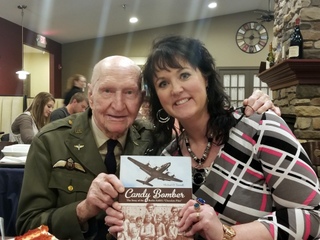
Unwrapping Storytelling Tips from the Candy Bomber
It was a typical evening in Denison, Iowa, when I stopped by the Hillside Grille Steakhouse, but I wasn’t there for the food, and this was no ordinary gathering. I had been invited to meet an authentic American hero, but I was afraid he’d be tired.
Col. Gail Halvorsen, 97, had flown into the Omaha airport on May 2, 2018, with his daughter late that afternoon from his home in the western United States. Turns out I didn’t need to worry about the energy level of this famed World War 2-era pilot. As soon as I sat down at the table near him at the Hillside Grille around 7:45 p.m., the “Candy Bomber” flashed me a big smile.
I knew this was going to be good. I had known it a few days earlier when my friend Vance Lundell, owner of Lundell Plastics in Odebolt, mentioned that the Candy Bomber was coming to western Iowa and invited me to meet the legendary pilot.
To understand the Candy Bomber’s story, let’s go back to 1948. World War 2 was over, but the war’s aftermath continued to ravage Europe. Life was especially grim in Berlin, Germany, which had become a divided city within a divided country.
The Soviets were attempting to cut off Western access to West Berlin, which was located deep inside Soviet-controlled East Germany. Soviet leader Josef Stalin blockaded all ground routes coming in and out of Berlin to cut off West Berliners from all food and other essential supplies. The blockade against the Western Allies threatened to crush a city that was already struggling against starvation. Without outside help, more than 2 million people might die.
In response, the United States and the United Kingdom launched the Berlin Airlift, a humanitarian rescue mission to airdrop food into West Berlin. Halvorsen was part of this effort. Not only did he help provide nourishment to the people of West Berlin, but he also gave the children a reason to hope for a better world—and it also started with two sticks of gum.
Halvorsen, like scores of other Western pilots, had been working 12 to 15 hours a day to deliver food and supplies at Berlin’s Tempelhof Airfield (which is now a public park) like clockwork. But only Halvorsen had an unlikely inspiration that would end up making him famous.
When he encountered some German children lingering at the edge of the air field, he offered two sticks of Wrigley’s chewing gum before departing. When he saw the excitement this small offering generated, the pilot promised to drop candy on his next flight.
When the children asked how they would know which of the huge airplanes was his, Halvorsen said he would wiggle his wings as he approached their position. “Uncle Wiggly Wings” was born.
Halvorsen lived up to his promise and inspired other pilots to donate their candy rations. Halvorsen started dropping chocolate, gum drops and other candy out his plane’s window as a treat for the emaciated Berlin kids often huddled together on the edge of the airfield. He even used spare handkerchiefs to rig up a little parachute for each load so the candy wouldn’t be squashed upon impact. “Operation Vittles” evolved into “Operation Little Vittles” as the Candy Bomber delivered candy and good cheer to the children of the blockaded city.
After newspapers got wind of what was happening, tons of donations of chocolate and other candy donations began pouring in from across America. Halvorsen had not only put a face on the Berlin Airlift, but he bolstered the U.S.’s humanitarian mission during the Cold War by enlisting the American public.
This was no small miracle, considering that Americans who had grown weary of continued food aid for Europe eagerly embraced the opportunity to give candy and chocolate to German children.
From one thoughtful, generous act came a lifelong friendship between the Candy Bomber and the children of Berlin. Halvorsen’s remarkable story is preserved in a number of books, including “Mercedes and the Chocolate Pilot,” a children’s book that tells the true story of a seven-year-old girl named Mercedes who lived in West Berlin during the airlift and still stays in touch with the Candy Bomber.
In fact, the Candy Bomber has been preparing to return to Germany this June for another visit with friends he made all those years ago. Maybe I shouldn’t have been surprised. Nothing seems to slow Halvorsen down—at least not for long. An hour and a half after I had arrived to meet him at the restaurant in Denison a few weeks ago, Halvorsen showed no signs of fatigue, even though it was well past 9 p.m., and he’d been busy giving media interviews and meeting new friends that evening.
When I asked Halvorsen how he was doing, his reply “I’m ready to go!” wasn’t a plea. It was a confident, spirited answer conveying his zest for life and his love of adventure. His Iowa adventure continue the next morning when he spoke to students at the school in Odebolt before flying home.
I admit—I’ve been a little surprised to learn that many Iowans aren’t familiar with the Candy Bomber, even though his story has been shared widely. I asked Halvorsen his thoughts on the importance of teaching history. “It’s important to remember, isn’t it? Thanks for teaching the youth.”
I want younger generations to know that thanks to Halvorsen’s efforts and those of his fellow pilots, the Allies held on to West Berlin and maintained support back home for the Berlin Airlift. By 1949, the Soviets lifted the blockade, and land delivery of food resumed.
It’s not just important, but essential, to share the stories of leaders like Halvorsen who prove how one person can make a positive difference and change the course of history. You just never know how much impact your story can have, not just now, but for generations to come. I’ll never forget one final insight my new friend, the Candy Bomber, shared that night in Denison. “The small things you do can turn into great things.”
Want more?
Thanks for stopping by. I invite you to read more of my blog posts if you value intriguing Iowa stories and history, along with Iowa food, agriculture updates, recipes and tips to make you a better communicator.
If you like what you see and want to be notified when I post new stories, be sure to click on the “subscribe to blog updates/newsletter” button at the top of this page, or click here. Feel free to share this with friends and colleagues who might be interested, too.
Also, if you or someone you know could use my writing services (I’m not only Iowa’s storyteller, but a professionally-trained journalist with 20 years of experience), let’s talk. I work with businesses and organizations within Iowa and across the country to unleash the power of great storytelling to define their brand and connect with their audience through clear, compelling blog posts, articles, news releases, feature stories, newsletter articles, social media, video scripts, and photography. Learn more at www.darcymaulsby.com, or e-mail me at yettergirl@yahoo.com.
If you’re hungry for more stories of Iowa history, check out my top-selling “Culinary History of Iowa: Sweet Corn, Pork Tenderloins, Maid-Rites and More” book from The History Press. Also take a look at my latest book, “Dallas County,” and my Calhoun County” book from Arcadia Publishing. Both are filled with vintage photos and compelling stories that showcase he history of small-town and rural Iowa. Order your signed copies today! Iowa postcards are available in my online store, too.
Let’s stay in touch. I’m at darcy@darcymaulsby.com, and yettergirl@yahoo.com.
Talk to you soon!
Darcy
@Copyright 2018 Darcy Maulsby & Co. Blog posts may only be reprinted with permission from Darcy Maulsby.
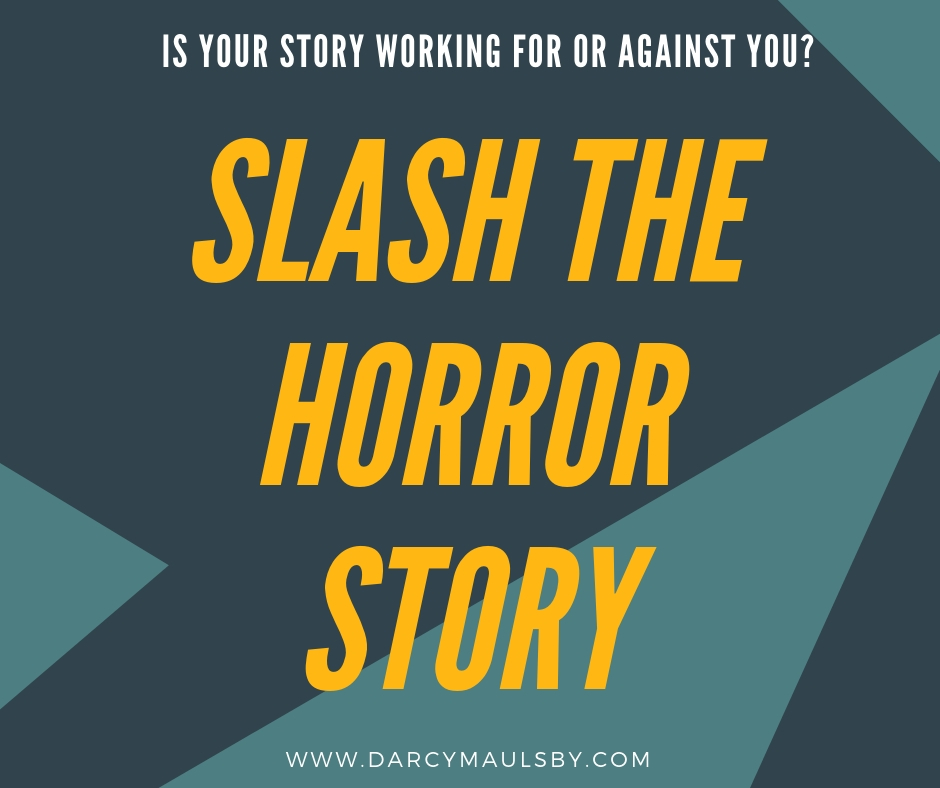
Are You Telling a Horror Story of Your Business?
Not sure how to tell your company’s story? I’d recommend staying away from a tactic a manufacturing company here in Iowa used recently when a group of local students toured the facility. Instead of sharing what makes the company unique and why it’s a great place to the work, the company’s tour guides detailed the many ways employees can earn demerits. If an employee gets a certain number of points, he or she can get fired.
While it’s essential to have high standards, the horror story this company chose to share painted a negative, grim view of this company. If I were a student on this tour, I’d definitely remember this place–but not in a good way. Would I want to work here? No way.
Instead of focusing on the negative, especially with people who are just becoming acquainted with your company, I recommend sharing the positive with your marketing and storytelling. Show how your business practices and company culture work together to help employees provide valuable products or services that make customers’ lives better. In the case of the students at the manufacturing plant, remember that these are future job seekers. Put yourself in their place. Share stories that help them discover career opportunities with companies like yours. Explain the education and training needed to succeed here. Encourage them envision the advantages of living and working in their hometown–at your company.
Need help identifying these kinds of stories and the best ways to share them? Let’s talk. #storytelling #manufacturing #business
Want more?
Thanks for stopping by. I invite you to read more of my blog posts if you value intriguing Iowa stories and history, along with Iowa food, agriculture updates, recipes and tips to make you a better communicator.
If you like what you see and want to be notified when I post new stories, be sure to click on the “subscribe to blog updates/newsletter” button at the top of this page, or click here. Feel free to share this with friends and colleagues who might be interested, too.
Also, if you or someone you know could use my writing services (I’m not only Iowa’s storyteller, but a professionally-trained journalist with 20 years of experience), let’s talk. I work with businesses and organizations within Iowa and across the country to unleash the power of great storytelling to define their brand and connect with their audience through clear, compelling blog posts, articles, news releases, feature stories, newsletter articles, social media, video scripts, and photography. Learn more at www.darcymaulsby.com, or e-mail me at yettergirl@yahoo.com.
If you’re hungry for more stories of Iowa history, check out my top-selling “Culinary History of Iowa: Sweet Corn, Pork Tenderloins, Maid-Rites and More” book from The History Press. Also take a look at my latest book, “Dallas County,” and my Calhoun County” book from Arcadia Publishing. Both are filled with vintage photos and compelling stories that showcase he history of small-town and rural Iowa. Order your signed copies today! Iowa postcards are available in my online store, too.
Let’s stay in touch. I’m at darcy@darcymaulsby.com, and yettergirl@yahoo.com.
Talk to you soon!
Darcy
@Copyright 2018 Darcy Maulsby & Co. Blog posts may only be reprinted with permission from Darcy Maulsby.

The Biggest Reason You Shouldn’t Slash Your Marketing Budget in Tough Times
I see it time and again. When companies have to trim the budget, marketing is often the first to feel the cuts. History has a great way of teaching us lessons, though, so let’s take a look at why this kind of cutting can actually hurt your business.
In the April 1927 issue of the Harvard Business Review, Roland S. Vaile published an article comparing companies that maintained their advertising spending during the 1923 recession to those that cut their budgets. He found that the biggest sales increases were recorded by companies that advertised the most.
Vaile’s research has been repeated during just about every recession ever since, and the results are always the same: Companies that cut their budgets during a recession performed worse during that recession and also in the subsequent years of recovery.
That’s why I zig when others zag. I don’t look at marketing as an expense. I don’t dial it back when my competition is cutting their marketing budgets. I view effective marketing, such as strategic storytelling connects with my target audience, as an investment that pays me back many times over.
Remember, if times are tough, your customers are looking for places to cut, too. Many are going to start looking for cheaper options, or they may stop buying certain products or services altogether. That may include YOUR products or services.
Take advantage of the opportunities that are created by your competitors’ cutbacks. As other companies slash their marketing, you can gain greater visibility and capture more market share. Don’t miss the opportunity to add real value through the helpful information and memorable stories that help answer your audience’s questions and position you as the expert who can help them.
Just because profits are elusive in tough times doesn’t mean cutting your marketing budget blindly is a smart move. Stay the course. History’s on your side.

How to Tell Your Community’s Story—with Style!
Every community has a wealth of interesting stories to tell. What makes your town unique? More importantly, how can you share those stories to drive tourism, welcome new businesses and residents and put your community on the map in a whole new way?
I call it “story selling,” and it works.
I first discovered the power of a story to inspire action in 1998 when I was a full-time editor at the Iowa Farm Bureau Spokesman. I had the chance to write about something interesting close to my home area of Lake City and Yetter (“Everything’s Better in Yetter”—what a town motto!).
The first thing that popped into my mind? The Jake Burger at the Yetter Café.
Now, granted, this was a tasty, thick, juicy burger, but it’s like a lot of other beef burgers. No secret sauce, wild ingredients or anything like that. What made the story come alive, though, was the restaurant owner.
Merlin “Jake” Janssen is one of those local characters who has done a little bit of everything in his life, from trucking to cooking. When he opened a café in an early 1900s-era two story clapboard home on Plum Street in Yetter, his Yetter Café soon developed a loyal following, from the employees at the ag co-op across the railroad tracks to area farmers to locals who wanted to see what all the fuss was about.
Not one to stick with boring names like “hamburger” or “cheeseburger,” Jake was a marketing wizard of sorts who named his most famous creation the Jake Burger. My story set the stage with all the sensory details, from the cozy feel of the tiny dining room to the savory aroma wafting from the kitchen as Jake fried the burgers. I also shared some of Jake’s backstory along the way, showing what sparked his interest in the restaurant business (I’m a people person!” he exclaimed) and what it’s like to run a café in a town of 35 people.
I described how the Jake Burger came with all the trimmings, from lettuce to tomato to onion. I noted that each culinary creation was prepared by Jake himself. For added spice, I dished about tales of how each Jake Burger was always served with a hearty side of small talk and wise cracks.
After my story and a photo of Jake with his namesake burger ran in the Spokesman, I asked Jake if he got much feedback from that article. “I sure did,” he said. “One guy drove all the way from Nashua to just to try a Jake Burger. Can you believe that?”
To the casual observer, it might seem unbelievable that someone would drive more than 150 miles one way to tiny town to eat a Jake Burger. But that, my friends, is the power of story.
Why does a good story matter?
Imagine a world without stories. If you’re like me, you can listen to a few facts, but not many before you start tuning out. In this hectic, distracted world, true stories well told are incredibly powerful, since they:
- Capture people’s attention
- Propel you past the dreaded “sales pitch syndrome” and invite people to relax and listen
- Put facts in context and make them relevant to your audience
- Convey complex information in a way that’s easy to understand
- Add value
- Build trust
- Boost your competitive advantage
- Showcase the quality of life in your community (arts, entertainment, economic development and more)
- Inspire people to share your content
- Make your community more memorable
- Encourage new businesses to locate in your area
- Attract more grants and investment in your community
- Help existing businesses grow and retain quality employees
- Honor the community’s history
- Enhance community pride
- Attract new residents
- Create momentum that translates into economic development
What makes a good story?
The first step is to identify the people and places that make your community unique. Story ideas might come from the new business that came to town in the last few years, or they might be inspired by the factory that’s been in the community for generations.
Good stories can be found at the local cafe that offers foods inspired by the region, or they can reflect the unique public art project that graces your town square. Compelling stories might include the historic highway that runs through your town and how this influenced the town’s growth, or a great story might focus on a must-see item at the local museum run by dedicated volunteers.
Above all, unforgettable stories revolve around people. Always humanize your stories to help them resonate with your audience.
How do I tell a good story?
Here are some do’s and don’ts:
- Do train your brain to always be looking for potential stories you can share.
- Don’t just rattle off lists of facts or opinions (our town has 2,500 people, we have 20 businesses in town, we are a progressive community, etc.). This information is important, but it’s not a story.
- Do learn what defines a story. Some of the best stories take a problem/solution format, almost like a case study. In my hometown of Lake City, Iowa, I think of Opportunity Living, a home for handicapped people. In a nutshell, the story is a classic problem/solution story that goes like this:
- “For generations, Lake City, Iowa, was a vibrant rural community and economic hub, but the 1980s Farm Crisis devastated the local area and led to the demise of many long-time businesses like Snyder Implement. Community leaders knew something needed to change, so they envisioned new possibilities for the large, vacant implement business on the east edge of town. Through their hard work, Opportunity Living took shape in the late 1980s and early 1990s and now provides homes throughout Lake City and Rockwell City for people with special needs. This dynamic organization also provides many jobs for local people and helps enhance the quality of life in the community.”
- Do use stories to show how people of all ages are making a positive difference in your community.
- Don’t forget to find partners throughout the community who can help you identify and share stories. Partner with the school, local businesses, volunteers, civic groups, church groups and others.
- Do choose your words carefully. Community leaders in Jefferson, Iowa, for example, doesn’t refer to vacant buildings as “empty buildings.” They call them “available buildings.”
How can I use my story to promote my community?
Here are some stories I’ve written about local entrepreneurs and tourism destinations:
Events Spark Stories That Help Backcountry Winery Grow in Iowa
Young Entrepreneur Grows a Healthy Business in Small-Town Iowa
Digging Deeper: Volunteers Showcase Thomas Jefferson Gardens
People are listening!
I received this wonderful note from Mary Weaver after I wrote the story about the Thomas Jefferson Gardens:
“On a very pleasant note, we are getting visitors because of the articles. We have, that we are aware of, three different sets of visitors from Humboldt. It is the type of visitor story we will tell the City Council when we report to them in September.
The best anecdote was a woman who was part of an assisted living bus tour that was coming to Jefferson from Humboldt, but the destination was the casino. She persuaded the driver her to bring her to TJG rather than the casino and she stayed the entire length of time the others were gambling.
The second was a couple I met yesterday during Tuesday Talks. It was their second visit for a “Tuesday Talk,” they ate at a local restaurant, went shopping at the quilt and antique store.
Certainly is the type of economic/tourism development we have been hoping to create. Thank you Darcy for your splendid articles about the Thomas Jefferson Gardens”
How can I use my story over and over?
Repurposing your stories is one of the smartest marketing moves you can make. Stories can take many forms, including blog posts, press releases, newspaper or magazine articles, videos, social media posts (for mini stories or links to your stories online), podcasts, speeches, photographs, advertisements and more. The key is to meet your audience where they’re at and use various marketing channels to spread the word.
Remember, if you don’t tell your story, who will? It’s a fun journey, and you stand so much to gain.
What if I don’t know where to start, or I just don’t have enough time to write my community’s stories?
If your budget allows, you might want to hire a professional storyteller. I understand the power of storytelling, because I’ve lived it and use it to grow my own business. As a trained journalist, book author, business owner, entrepreneur, marketer, historian and farmer, I offer you a writer’s skill, a storyteller’s artistry, an entrepreneur’s insight, a historian’s knowledge, and a farmer’s practicality.
My formal education includes bachelor’s degrees in journalism/mass communication and history from Iowa State University (ISU), along with a master’s degree in business administration (MBA) with an emphasis in marketing from ISU, but that’s just part of the story.
I also bring 20+ years of professional storytelling, writing and marketing experience and have served clients of all sizes, from local mom-and-pop businesses to multi-national corporations like Syngenta, help share their stories. I’m “bilingual” in terms of my ability to speak your language and the language that resonates with your clients and prospects.
When I started my writing/marketing business (Darcy Maulsby & Co.) in 2002, I learned the hard way that I can’t be everything to everybody. I’m not an expert in video production. I don’t like managing other people’s social media pages. I do specialize in storytelling, though, and am ready to put this powerful marketing tool to work for you.
I look forward to visiting with you to find out what makes your organization tick. Let’s discover those specific details and pivotal moments that make your stories relevant, relatable and unforgettable. Then I’ll show you how we can shape this raw material into stories that speak to the hearts and minds of your audience.
I invite you to connect with me at www.darcycmaulsby.com and on social media (I’m on Facebook, Twitter and Instagram). I look forward to staying in touch.
Want more?
Thanks for stopping by. I invite you to read more of my blog posts if you value intriguing Iowa stories and history, along with Iowa food, agriculture updates, recipes and tips to make you a better communicator.
If you like what you see and want to be notified when I post new stories, be sure to click on the “subscribe to blog updates/newsletter” button at the top of this page, or click here. Feel free to share this with friends and colleagues who might be interested, too.
Also, if you or someone you know could use my writing services (I’m not only Iowa’s storyteller, but a professionally-trained journalist with 20 years of experience), let’s talk. I work with businesses and organizations within Iowa and across the country to unleash the power of great storytelling to define their brand and connect with their audience through clear, compelling blog posts, articles, news releases, feature stories, newsletter articles, social media, video scripts, and photography. Learn more at www.darcymaulsby.com, or e-mail me at yettergirl@yahoo.com.
If you’re hungry for more stories of Iowa history, check out my top-selling “Culinary History of Iowa: Sweet Corn, Pork Tenderloins, Maid-Rites and More” book from The History Press. Also take a look at my latest book, “Dallas County,” and my Calhoun County” book from Arcadia Publishing. Both are filled with vintage photos and compelling stories that showcase he history of small-town and rural Iowa. Order your signed copies today! Iowa postcards are available in my online store, too.
Let’s stay in touch. I’m at darcy@darcymaulsby.com, and yettergirl@yahoo.com.
Talk to you soon!
Darcy
@Copyright 2018 Darcy Maulsby & Co. Blog posts may only be reprinted with permission from Darcy Maulsby.

Quit Using “Stupid Language”
Pop quiz—would you rather use lots of junk words and jargon that don’t mean anything, or speak like a real person and be a great communicator? Even “The Bob and Tom Show” hosts have had enough of “stupid language.”
Yep, “stupid language” is the term that came up this week when Kristi Lee was reading news headlines on “The Bob and Tom Show” as I was driving to Mid-Iowa Cooperative to work on their newsletter.
Here’s a snippet from the Jan. 8, 2018, Circuit City press release that triggered a lively debate:
“Circuit City is set to announce official company relaunch at the 2018 Consumer Electronics Show in Las Vegas on Monday January 8th at 3:00 PM PST during a special press event. Circuit City is expected to announce its official launch concentrated on the retail verticals of e-commerce, mobile, technology, omni-channel commerce.”
Huh?
That’s what Kristi, Bob, Tom and other hosts were asking. What exactly are retail verticals and omni-channel commerce?
Some of the radio hosts argued that the audience would be familiar with these terms. Others weren’t so sure and asked a key question: why not just clearly say what you mean?

Bob and Tom Show photo from http://www.955glo.com/shows/bob-tom/.
It didn’t get any better as the press release droned on about “enhancing the product discovery journey” and “relaunching with a new agenda of enhancing shopping experiences with cutting-edge technology.”
All this just made Circuit City the butt of endless jokes (including the flippant remark “what a douchebag,” referring to company leadership) on “The Bob and Tom Show,” a nationally-syndicated radio show with millions of listeners. We all got the message when one host put it bluntly. “Quit using stupid language.”
I couldn’t agree more.
Communicating to clarify or confuse—take your pick
Whether you call it stupid language or jargon, it abounds nearly everywhere you go, from business to politics to agriculture. Sometimes it’s not all bad. Jargon (including acronyms) can enhance communication by eliminating unnecessary words—but this only works when everyone knows this insider language.
If I start talking about N, P, and K rates or VRT, other farmers will know immediately I’m referring to nitrogen, phosphorus and potassium fertilizer and variable-rate technology. This wouldn’t be obvious to non-farmers, though.
You venture into the realm of “stupid language” when your audience doesn’t understand what you’re trying to say, and you make no effort to spell it out. It’s easy to see why audiences view jargon, buzzwords and corporate-speak as signs that you don’t have a clear grasp of what you want to say—or a clear grasp of your subject.
But this is just the start of the unsettling reality.
As a trained journalist who has interviewed thousands of people in the past 20 years, I’ve learned there’s an even more troubling reason why some people use complex, confusing language. They think that if they dress things up in clever, convoluted concepts, they can deflect the tough questions that cut to the core of tough challenges that rarely have quick or straightforward answers.
It’s the old smoke-and-mirrors trick, and it’s deadly to communicating like a leader.
3 tips to avoid the “stupid language” trap
So how to do choose words that influence and inspire, rather than confuse? Here are my three top tips:
1. Always keep your audience top of mind. Effective communication is not about sounding smart—it’s about sharing a useful message that resonates with your audience. Listen to your audience. What do they want (or need) to know? What would improve their life, solve a problem, help them reach their goals? Since the Circuit City press release was apparently geared towards the media, there are actually two audiences here—reporters and their readers, listeners or viewers. Reporters want an interesting, newsworthy story. Their audience wants tech news that’s presented clearly and shows them how technology (and the companies that supply it) can make their life easier and more enjoyable. Since the big story here is the relaunch of a brand that many people thought was dead, I’d focus on how the comeback of Circuit City will benefit the company’s self-proclaimed target audience of “legacy Circuit City customers to Millennials.”
2. Use simple language. Why use a $1 word when a 10-cent word will do? This isn’t dumbing down the language. This is effective communication. In the case of the Circuit City press release, don’t assume that everyone hearing this message is an electronics expert or techie. Skip the jargon and tech-speak. Instead of “omni-channel commerce,” which isn’t a common term to many people, try, “We sell online and offline and wants to serve people wherever it’s convenient for them, whether that’s in a physical store, an online store or on social media.”
3. Tell a story to support your key point. “Just the facts, ma’am” may have worked for Detective Joe Friday in the classic “Dragnet” TV series, but the facts alone are rarely enough to captivate an audience. Think about it. When you go to party, you don’t walk up to a group of people and say, “I’m pleased to report that I optimized my marketing plan this week to monetize my business.” You tell people a story about what happened. They become intrigued and ask questions. They might even tell others, if the story is compelling enough. With this kind of an exchange, you’ve just accomplished one of communication’s toughest objectives–creating a story that passes the “So what? Who cares?” test.
The bottom line? Be conscious of the language you use when you communicate, whether it’s an e-mail, an article, a speech or a media interview. Putting these three proven tips to work will help you avoid the pitfall of “stupid language”—and that’s no joke.
P.S. Thanks for joining me. I’m glad you’re here.
Want more?
Thanks for stopping by. I invite you to read more of my blog posts if you value intriguing Iowa stories and history, along with Iowa food, agriculture updates, recipes and tips to make you a better communicator.
If you like what you see and want to be notified when I post new stories, be sure to click on the “subscribe to blog updates/newsletter” button at the top of this page, or click here. Feel free to share this with friends and colleagues who might be interested, too.
Also, if you or someone you know could use my writing services (I’m not only Iowa’s storyteller, but a professionally-trained journalist with 20 years of experience), let’s talk. I work with businesses and organizations within Iowa and across the country to unleash the power of great storytelling to define their brand and connect with their audience through clear, compelling blog posts, articles, news releases, feature stories, newsletter articles, social media, video scripts, and photography. Learn more at www.darcymaulsby.com, or e-mail me at yettergirl@yahoo.com.
If you’re hungry for more stories of Iowa history, check out my top-selling “Culinary History of Iowa: Sweet Corn, Pork Tenderloins, Maid-Rites and More” book from The History Press. Also take a look at my latest book, “Dallas County,” and my Calhoun County” book from Arcadia Publishing. Both are filled with vintage photos and compelling stories that showcase he history of small-town and rural Iowa. Order your signed copies today! Iowa postcards are available in my online store, too.
Let’s stay in touch. I’m at darcy@darcymaulsby.com, and yettergirl@yahoo.com.
Talk to you soon!
Darcy
@Copyright 2018 Darcy Maulsby & Co.
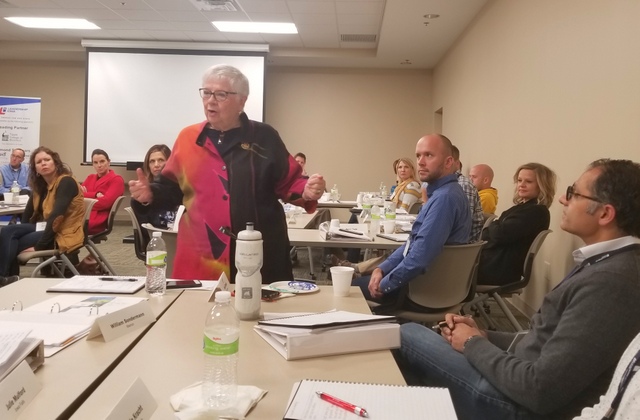
How Did We Get So Rude?
Ever come across something that takes on a deeper meaning every time you hear it? That’s how I felt when I scanned an online top 10 list of new year’s quotes and saw #8:
“Be at war with your vices, at peace with your neighbors and let every new year find you a better man.” — Benjamin Franklin
Seems like our society is increasingly mixing up the first two pieces of advice to the point where more people are at war with their neighbors and at peace with their vices, at least when it comes to rudeness. How did we get so rude? It made me think back to when I heard Mary Kramer articulate this pivotal issue.
I was in Winterset this fall when Kramer spoke to our class at Leadership Iowa, which is designed to instill passion in Iowa’s current and emerging leaders while fostering a high level of civic engagement. I saw a lot of heads nodding in agreement when Kramer, a former Republican state senator who was elected president of the Iowa Senate in 1997, tackled head-on the erosion of civil public discourse in America.
“We used to be able to debate with our adversaries without resorting to the demonization of one another,” said Kramer, a former United States Ambassador to Barbados and the Eastern Caribbean. “Back then, debates on important issues were challenging–even fun. Demonization used to be a last resort. Now we seem to begin with it.”
Demonization involves a shift from debating issues to attacking people. If we can destroy the career or the character of someone who is “getting it all wrong,” all would be well, or at least better.
It’s noxious process, Kramer stressed. Viewing those we disagree with as the embodiment of evil results in a profound loss of perspective on the humanity of our opponents. They stop being human beings like us, who happen to disagree on some issues.
Demonization isn’t limited to politics. It has spread like a cancer into entertainment, 24-hour news, social media and beyond. Its ubiquitous presence tempts people to cross the line between civility and rudeness without a second thought.
It also distorts reality. Just because someone passionately believe in something, does that belief allow him or her to mandate these views on everyone else?
No.
Not here, where generations of Americans have honored our heritage of meeting together, sharing information about a broad range of issues and seeking common ground. While our history isn’t one of perfect unity (far from it), we still found a way to move forward for the common good.
Let’s learn from the past and remind ourselves that the keys to combating this current rash of rudeness aren’t complex. They just require some human decency, a little kindness and a willingness to start with one key question: what problem are we trying to solve? I agree with Kramer that working together to agree on the problem statement often introduces common ground.
• Next, listen. Too often we underestimate the power of truly listening to others. Listen with curiosity, rather than “listening” with the intent to reply.
• Ask clarifying questions. Try to understand why people believe the way they do. Don’t just rush to judgement. Ask sincere (not snarky) questions, and try to discover what motivates someone to feel the way they do. As a writer who has interviewed thousands of people, I’m still sometimes shocked by the answers people give me. Plus, their viewpoints either challenge me to reconsider my own views or at least clarify why I believe what I believe.
• Acknowledge the validity of the other person’s position. While you don’t have to agree with someone’s viewpoint, you can and should acknowledge their position. Consider a controversial topic like water quality. Even if I don’t agree with someone’s opinion about the way to address this challenge, I can acknowledge this person’s concerns and validate the goal of clean, healthy drinking water.
Sure, not everyone who disagrees with you will follow this advice. Still, you’ve set the stage for more productive conversations, rather than head-on collisions propelled by rudeness.
Also, be encouraged by these words that Kramer came across years ago and shared with us at Leadership Iowa:
• Iowa is the place where the dream still lives.
• Iowa is the America we grew up believing in. It is liberty bought by hard work and integrity.
• It’s the belief that the future will be even better than today if we will work to make it that way.
So – can we talk? More important, can we listen?
This column originally appeared in January 2018 in Farm News.
P.S. Thanks for joining me. I’m glad you’re here.
Want more?
Thanks for stopping by. I invite you to read more of my blog posts if you value intriguing Iowa stories and history, along with Iowa food, agriculture updates, recipes and tips to make you a better communicator.
If you like what you see and want to be notified when I post new stories, be sure to click on the “subscribe to blog updates/newsletter” button at the top of this page, or click here. Feel free to share this with friends and colleagues who might be interested, too.
If you’re hungry for more stories of Iowa history, check out my top-selling “Culinary History of Iowa: Sweet Corn, Pork Tenderloins, Maid-Rites and More” book from The History Press. Also take a look at my latest book, “Dallas County,” and my Calhoun County” book from Arcadia Publishing. Both are filled with vintage photos and compelling stories that showcase he history of small-town and rural Iowa. Order your signed copies today! Iowa postcards are available in my online store, too.
Also, if you or someone you know could use my writing services (I’m not only Iowa’s storyteller, but a professionally-trained journalist with 20 years of experience), let’s talk. I work with businesses and organizations within Iowa and across the country to unleash the power of great storytelling to define their brand and connect with their audience through clear, compelling blog posts, articles, news releases, feature stories, newsletter articles, social media, video scripts, and photography. Learn more at www.darcymaulsby.com, or e-mail me at yettergirl@yahoo.com.
Let’s stay in touch. I’m at darcy@darcymaulsby.com, and yettergirl@yahoo.com.
Talk to you soon!
Darcy
@Copyright 2018 Darcy Maulsby & Co.

Free Gifts! (Let’s Talk Listening, Stories and History)
Are you ready for Christmas? I’m not, and I’m totally ok with that.
Yep, I’ve still got baking to do, my house is messy (no surprise) and I barely got the Christmas tree up at a respectable time. One bright spot? I’ve got a pretty good handle on gifts, thanks to my travels across Iowa. I don’t stop with tangible gifts, though. As someone who believes in communicating like a leader and preserving history, I know many of the most meaningful gifts go far beyond items you can buy in the store. Best of all, these gifts are free and can be replenished anytime.
This year, be sure to give:
• The gift of listening. Remember how you felt the last time someone really listened to you? It’s so powerful, especially in this age of digital distractions. There’s something about being heard—truly heard—that fulfills a deep-seated human need for connection. It’s a bonus that listening also offers a great way to learn.
• The gift of stories. Humans also have a deep-seated need for stories. Our brains are wired to remember stories much more that data and facts. Plus, stories can be fun. Not sure where to start? Share stories of your favorite Christmas memories to start a conversation. Since I’m a food writer, you can bet many of my stories revolve around food. Here’s a goodie from my archives about how Lake City’s Shakespeare Club, of which I’m a member, has maintained good taste in small-town Iowa for more than 123 years. (Don’t miss the recipes for my Healthy Corn Tortellini Chowder, Cheesy Artichoke Dip and a festive Celebration Slush.)
• The gift of history. Speaking of memories, pull out the old family photo albums (please tell me you still have some around, right?), or watch your vintage home movies, and have a blast remembering the way you were. I guarantee younger generations will get a kick out of seeing your swinging ‘60s vibe, your ‘70s disco style, your ‘80s mullet or whatever defined your look back in the day. I also love sharing resources that bring history to life with stories and images. Maybe that’s why I’m such a huge fan of Coca Cola Journeys, in which Coca Cola’s top-notch team shares the most interesting stories ranging from storied history of Notre Dame football (and the Coca-Cola connection) to The Story of the Coca-Cola Polar Bears: How Man’s Best Friend Provided the Creative Inspiration Behind the Beloved Icons.
Enjoy these free gifts, my friends, and share the gifts of listening, stories and history with others, not just during the holidays, but year-round.
Have any stories or family history you like to share, especially during the holiday season? Feel free to start the conversation here. I’m listening!
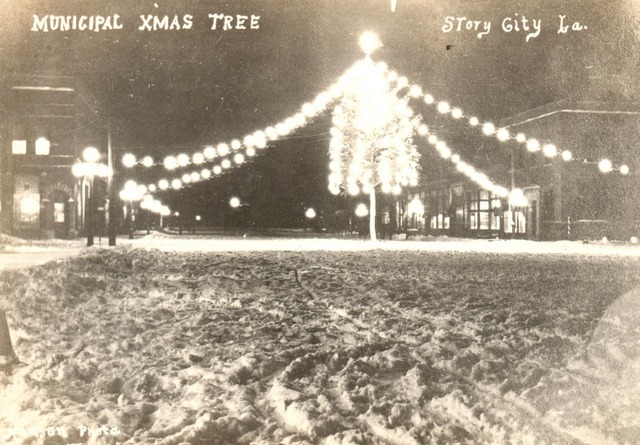
Yep, Iowans love to put Christmas trees in the middle of the street, and many communities have been doing this for generations. Click on the photo for the whole story.
Want more?
Thanks for stopping by. I invite you to read more of my blog posts if you value intriguing Iowa stories and history, along with Iowa food, agriculture updates, recipes and tips to make you a better communicator.
If you like what you see and want to be notified when I post new stories, be sure to click on the “subscribe to blog updates/newsletter” button at the top of this page, or click here. Feel free to share this with friends and colleagues who might be interested, too.
If you’re hungry for more stories of Iowa history, check out my top-selling “Culinary History of Iowa: Sweet Corn, Pork Tenderloins, Maid-Rites and More” book from The History Press. Also take a look at my latest book, “Dallas County,” and my Calhoun County” book from Arcadia Publishing. Both are filled with vintage photos and compelling stories that showcase he history of small-town and rural Iowa. Order your signed copies today! Iowa postcards are available in my online store, too.
Also, if you or someone you know could use my writing services (I’m not only Iowa’s storyteller, but a professionally-trained journalist with 20 years of experience), let’s talk. I work with businesses and organizations within Iowa and across the country to unleash the power of great storytelling to define their brand and connect with their audience through clear, compelling blog posts, articles, news releases, feature stories, newsletter articles, social media, video scripts, and photography. Learn more at www.darcymaulsby.com, or e-mail me at yettergirl@yahoo.com.
Let’s stay in touch. I’m at darcy@darcymaulsby.com, and yettergirl@yahoo.com.
Talk to you soon!
Darcy
P.S. Thanks for joining me. I’m glad you’re here.
@Copyright 2018 Darcy Maulsby & Co.

Does Accuracy Even Matter Anymore?
Maybe I’m old-school, but I find myself longing for the days when journalists—or anyone writing content and sharing it with others—at least attempted to get the facts straight.
Is this an unreasonable request? It seems so, in this era of fake news and being “first rather than accurate.”
That’s why this issue bugs me so much.
It started last week when I saw an article in an online ag news outlet about how 2017 yields weren’t dampened by wet harvest conditions. Then I saw that the article quoted some grain marketing specialists, including my friend Karl from Iowa, although they called him Carl. The errors didn’t stop there.
Instead of listing his proper title of risk management team leader, the writer called him a “risk leader.” Wow—there’s a big difference between a risk leader and a risk management leader, I’d say.
I couldn’t resist e-mailing Karl.
From: Darcy Maulsby [mailto:yettergirl@yahoo.com]
Sent: Wednesday, November 01, 2017 10:13 AM
To: Karl
Hey Karl,
I see that you’re now Carl, risk leader. Cool title! 🙂
Hope you’re doing well.
Take care,
Darcy
From: Karl
To: Darcy Maulsby <yettergirl@yahoo.com>
Sent: Wednesday, November 1, 2017 10:19 AM
HAHAHA!!!
What’s even worse is I spelled out my name, first and last, to him, and my job title.
I believe he was an intern and was past the point of caring.
From: Darcy Maulsby [mailto:yettergirl@yahoo.com]
Sent: Wednesday, November 01, 2017 10:24 AM
To: Karl
Oh no–you handed him the info. on the silver platter, and he still screwed it up! Yes, definitely past the point of caring. Good thing he’s not a grain marketer. 🙂
From: Karl
To: Darcy Maulsby <yettergirl@yahoo.com>
Sent: Wednesday, November 1, 2017 10:22 AM
Exactly.
And the hits keep coming
Then I had my own brush with inaccurate reporting. I offering a history program and book signing in central Iowa recently. The event was covered in the local press, which was great, until I spotted three errors in one 22-word sentence.
I learned that I moved to Granger (not true—I still live in the country near Lake City and Yetter), my latest book came out last September (not exactly–it was released Sept. 4, 2017), and my book is called “Dallas County Images.” (Strike three. It’s “Dallas County,” which is part of Arcadia Publishing’s Images of America series).
Before I even read the article, I knew something was wrong, because a friend e-mailed me and asked if it were true that I had moved to Granger. (I lived near Granger from 2001-2006, and while it’s a great place, I have no plans to move back.) Oh boy.
Let’s bring accuracy back
So these two recent examples left me with one question. Why were there so many careless errors that the writers could easily have avoided?
I know we’re all human and make mistakes. Believe me, through the years I’ve had plenty of typos and mistakes creep into my writing that has been published in print and online. Still, I try to get it right by:
• Becoming a world-class listener
• Taking good notes
• Asking questions for clarification
• Doing my homework (such as checking the proper spelling of names, titles, dates, etc.)
• Requesting that the source (when appropriate) review information for factual accuracy
• Striving to do better and tell the most accurate, interesting stories possible
While these are helpful tips for any of us who want to become better communicators, they are essential for professional communicators. I don’t believe it’s unfair to hold professional communicators to a higher standard.
After all, accuracy isn’t old-fashioned, even if it is increasingly rare. It’s vital for clear communication that positions you as a trusted resource—an advantage that will never go out of style.
What’s your take?
So now I’d like to hear from you. What are your pet peeves when it comes accuracy (or the lack thereof) in communication? Join the discussion, and leave a comment.
Want more?
Thanks for stopping by. I invite you to read more of my blog posts if you value intriguing Iowa stories and history, along with Iowa food, recipes and tips to make you a better communicator.
If you like what you see and want to be notified when I post new stories, be sure to click on the “subscribe to blog updates/newsletter” button at the top of this page. Feel free to share this information with friends and colleagues who might be interested, too.Also, if you or someone you know could use my writing services (I’m not only Iowa’s storyteller, but a professionally-trained journalist with 20 years of experience), let’s talk. I work with businesses and organizations within Iowa and across the country to unleash the power of great storytelling to define their brand and connect with their audience through clear, compelling blog posts, articles, news releases, feature stories, newsletter articles, social media, video scripts, and photography. Learn more at www.darcymaulsby.com, or e-mail me at yettergirl@yahoo.com.
Talk to you soon!
Darcy
P.S. Thanks for joining me. I’m glad you’re here.
@Copyright 2017 Darcy Maulsby & Co.
